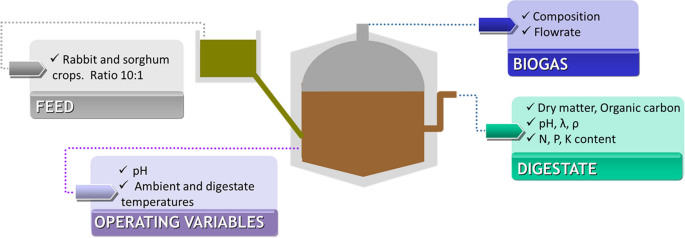当前位置:
X-MOL 学术
›
Bioresour. Bioprocess.
›
论文详情
Our official English website, www.x-mol.net, welcomes your
feedback! (Note: you will need to create a separate account there.)
Anaerobic co-digestion of rabbit manure and sorghum crops in a bench-scale biodigester
Bioresources and Bioprocessing ( IF 4.3 ) Pub Date : 2020-07-16 , DOI: 10.1186/s40643-020-00327-5 María Esperanza Adrover , Ivana Cotabarren , Ezequiel Madies , Manuel Rayes , Sabrina Belén Rodriguez Reartes , Marisa Pedernera
Bioresources and Bioprocessing ( IF 4.3 ) Pub Date : 2020-07-16 , DOI: 10.1186/s40643-020-00327-5 María Esperanza Adrover , Ivana Cotabarren , Ezequiel Madies , Manuel Rayes , Sabrina Belén Rodriguez Reartes , Marisa Pedernera
Any type of biomass can be used as substrate for biogas production, but the performance of the biodigestion depends on the composition of the feed, and no direct extrapolation of the yield of the process from one substrate to another can be made. In this work, the performance of a bench-scale anaerobic biodigester of 93 L installed at ambient conditions is studied. The biodigester was set up in a region where temperature varies significantly during the year, and was operated under semi-batch conditions with non-thermal control for 16 months with a feed of rabbit manure and ground sorghum grains. To our knowledge, this is the first time the co-digestion of rabbit manure with sorghum grains is considered. To evaluate the biodigestion performance, critical operational variables (pH, temperature, biogas flowrate) were monitored, and composition of substrate, digestate and produced biogas was determined. Moreover, the following variables were quantified: (a) the theoretical methane potential, (b) the specific methane yield and (c) the degree of degradation of the substrate. A 1-D non-stationary model was formulated and validated with experimental data in order to analyze, in a theoretical form, the impact of incorporating thermal insulation to the unit. The results show that is it possible to produce biogas in a bench-scale biodigester, with a novel feed of rabbit manure and ground sorghum grains, in a region with significant temperature changes along the year. Moreover, it is shown that the 1-D model constitutes a useful tool for the design or improvement of biodigesters regarding the insulation system and the warming policies.
中文翻译:

台式生物消化器中厌氧消化兔粪和高粱作物
任何类型的生物质都可以用作沼气生产的底物,但是生物消化的性能取决于进料的组成,因此无法直接将过程的产量从一种底物推算到另一种底物上。在这项工作中,研究了在环境条件下安装的93升台式厌氧生物消化器的性能。生物消化器设置在一年中温度变化显着的区域,并在半分批条件下进行非热控制操作,持续16个月,并饲喂兔子粪便和高粱粉。据我们所知,这是首次考虑将兔子粪便与高粱谷物一起消化。为了评估生物消化性能,监测了关键的操作变量(pH,温度,沼气流量),测定底物,消化物和产生的沼气的组成。此外,对以下变量进行了定量:(a)理论甲烷潜力,(b)特定甲烷产量,(c)底物的降解程度。制定了一维非平稳模型并用实验数据进行验证,以便以理论形式分析将隔热材料引入设备的影响。结果表明,可以在一个台式规模的沼气池中生产沼气,该沼气采用新颖的兔粪和高粱粉饲料,在这一年中温度会发生明显变化。而且,表明1-D模型构成用于设计或改善关于绝热系统和加热策略的生物消化器的有用工具。确定消化液和产生的沼气。此外,对以下变量进行了定量:(a)理论甲烷潜力,(b)特定甲烷产量,(c)底物的降解程度。制定了一维非平稳模型并用实验数据进行验证,以便以理论形式分析将隔热材料引入设备的影响。结果表明,可以在一个台式规模的沼气池中生产沼气,该沼气采用新颖的兔粪和高粱粉饲料,在这一年中温度会发生明显变化。而且,表明1-D模型构成用于设计或改善关于绝热系统和加热策略的生物消化器的有用工具。确定消化液和产生的沼气。此外,对以下变量进行了定量:(a)理论甲烷潜力,(b)特定甲烷产量,(c)底物的降解程度。制定了一维非平稳模型并用实验数据进行验证,以便以理论形式分析将隔热材料引入设备的影响。结果表明,可以在一个台式规模的沼气池中生产沼气,该沼气采用新颖的兔粪和高粱粉饲料,在这一年中温度会发生明显变化。而且,表明1-D模型构成用于设计或改善关于绝热系统和加热策略的生物消化器的有用工具。(a)甲烷的理论电势,(b)特定的甲烷收率,以及(c)底物的降解程度。制定了一维非平稳模型并用实验数据进行验证,以便以理论形式分析将隔热材料引入设备的影响。结果表明,可以在一个台式规模的沼气池中生产沼气,该沼气采用新颖的兔粪和高粱粉饲料,在这一年中温度会发生明显变化。而且,表明1-D模型构成用于设计或改善关于绝热系统和加热策略的生物消化器的有用工具。(a)甲烷的理论电势,(b)特定的甲烷收率,以及(c)底物的降解程度。制定了一维非平稳模型并用实验数据进行验证,以便以理论形式分析将隔热材料引入设备的影响。结果表明,可以在一个台式规模的沼气池中生产沼气,该沼气采用新颖的兔粪和高粱粉饲料,在这一年中温度会发生明显变化。而且,表明1-D模型构成用于设计或改善关于绝热系统和加热策略的生物消化器的有用工具。制定了一维非平稳模型并用实验数据进行验证,以便以理论形式分析将隔热材料引入设备的影响。结果表明,可以在一个台式规模的沼气池中生产沼气,该沼气采用新颖的兔粪和高粱粉饲料,在这一年中温度会发生明显变化。而且,表明1-D模型构成用于设计或改善关于绝热系统和加热策略的生物消化器的有用工具。制定了一维非平稳模型并用实验数据进行验证,以便以理论形式分析将隔热材料引入设备的影响。结果表明,可以在一个台式规模的沼气池中生产沼气,该沼气采用新颖的兔粪和高粱粉饲料,在这一年中温度会发生明显变化。而且,表明1-D模型构成用于设计或改善关于绝热系统和加热策略的生物消化器的有用工具。在全年温度变化显着的地区 而且,表明1-D模型构成用于设计或改善关于绝热系统和加热策略的生物消化器的有用工具。在全年温度变化显着的地区 而且,表明1-D模型构成用于设计或改善关于绝热系统和加热策略的生物消化器的有用工具。
更新日期:2020-07-16

中文翻译:

台式生物消化器中厌氧消化兔粪和高粱作物
任何类型的生物质都可以用作沼气生产的底物,但是生物消化的性能取决于进料的组成,因此无法直接将过程的产量从一种底物推算到另一种底物上。在这项工作中,研究了在环境条件下安装的93升台式厌氧生物消化器的性能。生物消化器设置在一年中温度变化显着的区域,并在半分批条件下进行非热控制操作,持续16个月,并饲喂兔子粪便和高粱粉。据我们所知,这是首次考虑将兔子粪便与高粱谷物一起消化。为了评估生物消化性能,监测了关键的操作变量(pH,温度,沼气流量),测定底物,消化物和产生的沼气的组成。此外,对以下变量进行了定量:(a)理论甲烷潜力,(b)特定甲烷产量,(c)底物的降解程度。制定了一维非平稳模型并用实验数据进行验证,以便以理论形式分析将隔热材料引入设备的影响。结果表明,可以在一个台式规模的沼气池中生产沼气,该沼气采用新颖的兔粪和高粱粉饲料,在这一年中温度会发生明显变化。而且,表明1-D模型构成用于设计或改善关于绝热系统和加热策略的生物消化器的有用工具。确定消化液和产生的沼气。此外,对以下变量进行了定量:(a)理论甲烷潜力,(b)特定甲烷产量,(c)底物的降解程度。制定了一维非平稳模型并用实验数据进行验证,以便以理论形式分析将隔热材料引入设备的影响。结果表明,可以在一个台式规模的沼气池中生产沼气,该沼气采用新颖的兔粪和高粱粉饲料,在这一年中温度会发生明显变化。而且,表明1-D模型构成用于设计或改善关于绝热系统和加热策略的生物消化器的有用工具。确定消化液和产生的沼气。此外,对以下变量进行了定量:(a)理论甲烷潜力,(b)特定甲烷产量,(c)底物的降解程度。制定了一维非平稳模型并用实验数据进行验证,以便以理论形式分析将隔热材料引入设备的影响。结果表明,可以在一个台式规模的沼气池中生产沼气,该沼气采用新颖的兔粪和高粱粉饲料,在这一年中温度会发生明显变化。而且,表明1-D模型构成用于设计或改善关于绝热系统和加热策略的生物消化器的有用工具。(a)甲烷的理论电势,(b)特定的甲烷收率,以及(c)底物的降解程度。制定了一维非平稳模型并用实验数据进行验证,以便以理论形式分析将隔热材料引入设备的影响。结果表明,可以在一个台式规模的沼气池中生产沼气,该沼气采用新颖的兔粪和高粱粉饲料,在这一年中温度会发生明显变化。而且,表明1-D模型构成用于设计或改善关于绝热系统和加热策略的生物消化器的有用工具。(a)甲烷的理论电势,(b)特定的甲烷收率,以及(c)底物的降解程度。制定了一维非平稳模型并用实验数据进行验证,以便以理论形式分析将隔热材料引入设备的影响。结果表明,可以在一个台式规模的沼气池中生产沼气,该沼气采用新颖的兔粪和高粱粉饲料,在这一年中温度会发生明显变化。而且,表明1-D模型构成用于设计或改善关于绝热系统和加热策略的生物消化器的有用工具。制定了一维非平稳模型并用实验数据进行验证,以便以理论形式分析将隔热材料引入设备的影响。结果表明,可以在一个台式规模的沼气池中生产沼气,该沼气采用新颖的兔粪和高粱粉饲料,在这一年中温度会发生明显变化。而且,表明1-D模型构成用于设计或改善关于绝热系统和加热策略的生物消化器的有用工具。制定了一维非平稳模型并用实验数据进行验证,以便以理论形式分析将隔热材料引入设备的影响。结果表明,可以在一个台式规模的沼气池中生产沼气,该沼气采用新颖的兔粪和高粱粉饲料,在这一年中温度会发生明显变化。而且,表明1-D模型构成用于设计或改善关于绝热系统和加热策略的生物消化器的有用工具。在全年温度变化显着的地区 而且,表明1-D模型构成用于设计或改善关于绝热系统和加热策略的生物消化器的有用工具。在全年温度变化显着的地区 而且,表明1-D模型构成用于设计或改善关于绝热系统和加热策略的生物消化器的有用工具。












































 京公网安备 11010802027423号
京公网安备 11010802027423号